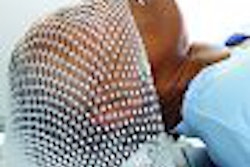
Now, Liyong Lin, Ph.D., of the University of Florida Proton Therapy Institute in Jacksonville and researchers at the University of Wisconsin-Madison have developed a new brachytherapy scheme that could overcome this limitation. The treatment is based on the use of iodine-125 (I-125), a low-energy source that delivers less dose to adjacent organs than Iridium-192 (Ir-192), the isotope generally employed for high-dose-rate (HDR) brachytherapy (Medical Physics, January 2008, Vol. 35:1, pp. 240-247).
One consequence of using a low-energy radionuclide is that it can be shielded with a thin layer of high-Z material (such as lead or gold), a feature that enabled the research team to integrate an internal radiation shield within the source itself. The resulting directional source offers reduced radiation intensity in the shielded direction, while maintaining a similar dose distribution as a conventional brachytherapy seed on the unshielded side.
The research team proposes that the improvements offered by directional low-dose-rate (LDR) I-125 brachytherapy will enable a greater number of patients to benefit from APBI. The shielded source may also enable treatment of tumors closer to the surface or chest wall, for example, as well as larger lesions and tumors in smaller breasts.
Directing the dose
The directional source was created by placing an I-125-coated nylon filament (4 mm long, 0.2 mm diameter) on top of a gold shield (4 mm long, 0.6 mm wide, 0.2 mm thick) and encasing these components in a D-shaped titanium tube. The researchers optimized the design to achieve a uniform dose over a 180° sector and a sufficiently shielded dose over a 90° sector. The sources are contained within catheters that are temporarily implanted during the treatment.
To investigate the potential of the new brachytherapy source, Lin and colleagues Douglass Henderson, Ph.D.; Bruce Thomadsen, Ph.D.; and Dr. Rakesh Patel compared a treatment plan for a patient treated using HDR Ir-192 interstitial brachytherapy with a directional LDR I-125 treatment plan using the same dataset.
The conventional HDR treatment comprised 34 Gy delivered twice daily in 10 fractions, while the simulated directional LDR brachytherapy delivered 45 Gy continuously over 4.5 days. Both plans used 31 catheters, with the LDR treatment employing a combination of conventional and directional I-125 sources.
The two plans achieved similar target-volume dose, with 97.5% and 99.2% tumor coverage for HDR and directional LDR treatments, respectively. The directional LDR scheme, however, significantly reduced the dose to the patient's skin, in both physical and biological terms.
Calculating the skin-surface areas receiving x% of the prescribed dose (Sx) demonstrated that directional LDR reduced S30 by 50% (from 100.6 cm² to 49.5 cm²) based on physical equivalence, and by 38% (to 62.5 cm²) in terms of biological equivalence. S50 was reduced from 50.6 cm² for the HDR plan to 8.5 cm² in the LDR plan on a physical basis, and to 16.1 cm² biologically.
The researchers also noted that the dose to the rest of the breast (excluding the tumor bed) was better controlled by directional LDR brachytherapy, with a reduction of more than a 100 cm3 (from 489.2 cm3 to 386.1 cm3) in V50, the volume receiving 50% of the prescription dose. V150 and V100 were similar for both schemes.
Prostate possibilities
Work so far has entailed a feasibility study comparing plans based on patient data. "Actual patient treatment is expected as part of a clinical trial, probably in about a year's time," Lin told medicalphysicsweb. "We are preparing a grant application that should help move toward the clinical trial."
Future plans also include extending the use of directional sources beyond breast brachytherapy. "A discussion of the application for prostate treatment is being submitted for publication; many of the questions are different," Lin explained. "The grant application should benefit both breast and prostate treatment, although in my opinion the breast trials will probably start sooner."
By Tami Freeman
Medicalphysicsweb science editor
March 17, 2008
Related Reading
Breast IMRT without the overspill, March 3, 2008
Good vibrations stave off blood-borne diseases, February 11, 2008
Toxicity levels with gynecologic chemoradiation deemed acceptable, November 28, 2007
Cell survival offers IMRT insight on 'bystander effect,' November 23, 2007
Lung function guides IMRT planning, October 24, 2007
© IOP Publishing Limited. Republished with permission from medicalphysicsweb, a community Web site covering fundamental research and emerging technologies in medical imaging and radiation therapy.



















